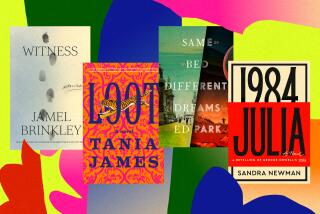Review: In Ishiguroâs âThe Buried Giant,â memory draws a blank
Kazuo Ishiguro has made a career of the unexpected. His best-known novel, 1989âs Man Booker-winning âThe Remains of the Day,â is narrated by an English butler looking back on the love he let elude him on a country estate in the years leading to World War II. âWhen We Were Orphansâ (2000) comes framed as a detective novel, while âNever Let Me Goâ (2005) appropriates some of the tropes of science fiction to tell the story of a boarding school where clones are raised for body parts.
What these books share is a fascination with memory, identity, with the tension between obligation and desire. âIâm wondering,â an elderly woman named Beatrice says in Ishiguroâs new novel âThe Buried Giant,â âif without our memories, thereâs nothing for it but for our love to fade and die.â
Beatrice is one of the central figures in âThe Buried Giant,â which takes place in an ancient England, within living recollection of King Arthurâs reign. As the book begins, she and her aged husband, Axl, set out in search of their son, who left them years before. âI would say this couple lived an isolated life,â Ishiguro writes, establishing a frame, âbut in those days few were âisolatedâ in any sense we would understand. For warmth and protection, the villagers lived in shelters, many of them dug deep into the hillside, connected one to the other by underground passages and covered corridors.â
This is an interesting but problematic passage, suggesting the potential of âThe Buried Giantâ and also the failings it cannot, finally, overcome. First, who is that first-person narrator, the âIâ who speaks to us directly? When and where is this voice writing from? The answer, revealed in the novelâs final pages, is both confusing and unsatisfying, not to mention inconsistent, a surprising structural flaw.
Then, thereâs the tone of exposition, of a story explicated rather than told. Certainly, âThe Buried Giantâ requires explanation, its world so different from the one we occupy. At the same time, this leaves the narrative at a peculiar distance, one Ishiguro never overcomes. Again and again, his characters clarify for one another: not just the social dynamics â villages of Saxons and Britons, living under a cloud of forgetting â but also the plot.
One favored device is to have Axl or another figure comment about what has happened, using dialogue to propel the narrative. âYou read it well, Master Wistan, and I shudder at what you show me,â Axl tells a Saxon warrior, after the latter suggests that the monastery in which theyâve sought shelter was likely once a fort. Thereâs a tension to such a revelation, but it is undercut by the secondhand approach.
This raises a question about Ishiguroâs inspiration, his intentions for the book. On the one hand, he remains, as he has often been, compelled by questions of love, commitment, deception â a deception that is not always external but also grows within. The cloud of forgetting here is real, the result of a spell cast on a dragon named Querig, whose exhalations provoke a collective state of somnolence. And yet, the truest implications have to do with the charactersâ apprehension about what will emerge once the spell is removed.
âIâve said it before, Axl,â Beatrice tells her husband. â⌠[T]hereâs a part of me that fears the mistâs fading.â He seeks to reassure her, but as his memories return in bits and pieces, he too begins to fear what he will discover about his past. Who was he before he fell into a sort of blankness? Will he be able to live with all that he has done?
This is complicated by the presence of Wistan, with whom he develops a connection, and the emergence of Sir Gawain (yes, that Sir Gawain), both of whom are after the dragon also, for deep and hidden reasons of their own.
In the hands of, say, T.H. White or George R.R. Martin, this could be (has been) a vivid set of conflicts, played out on an epic stage. âThe Buried Giant,â though, is too thin, too narrow in its vision, to achieve that sort of scope. Rather, it feels constrained, not fully imagined, as if the distance were not only in the narrative but also in the author himself.
Partly, itâs that the novel is claustrophobic, with just a handful of articulated characters â Axl, Beatrice, Gawain, Wistan and Wistanâs protĂŠgĂŠ, a Saxon boy named Edwin. Partly, itâs because the forgetting, the amnesia, removes a sense of history, personal or otherwise. This is mitigated in the final chapters, but by then it is too late.
In the main, âThe Buried Giantâ involves people with no real sense of their own past wandering through a landscape with no real sense of its own past, with consequences that donât seem dire or dangerous enough, which means that nothing, really, is at stake.
This is not to say that the book lacks anything to merit our attention: The era of Arthur remains a rich source of legend and adventure, while the relationship between Axl and Beatrice is often moving, a portrait of love in the shadow of old age.
âIt would be the saddest thing to me, princess,â he tells her. âTo walk separately from you, when the ground will let us go as we always did.â Yet even that is not enough to bring this misbegotten novel to life.
The Buried Giant
A Novel
Kazuo Ishiguro
Alfred A. Knopf: 318 pp., $26.95
More to Read
Sign up for our Book Club newsletter
Get the latest news, events and more from the Los Angeles Times Book Club, and help us get L.A. reading and talking.
You may occasionally receive promotional content from the Los Angeles Times.








